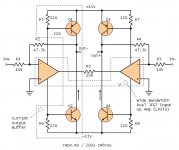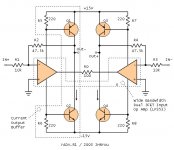Nelson Pass said:
Buy a scope.
:Off-topic:
Is this a scope good enough?
- Bandwidth: 60MHz
- Channel: 2
- Sample rate 1 GS/s
Thanks again.
JH
So, if I were to build Rookie's circuit as an experiment, I would first have to get a balanced signal, I assume using something like a BB DRV134 would be the simplest way?
Or am I missing the point😉
Or am I missing the point😉
 I could not find LM6181 seller in this country. Too bad...
I could not find LM6181 seller in this country. Too bad...Probably, I might need to go for YAMX. Why not? Nelson Pass kindly posted the simplified YAMX. ... saying, "enjoy."
Mmm... Enjoy... Enjoy the puzzle...?!?!
Here is my struggling to the puzzle. I like to use LF353 (wide bandwidth dual JFET input op amp). Since it is a low power op amp, I need external current output buffers with complementary power transistors, which allow high current swing to the load. R1 and R3 are to set input impedance. R2 and R4 are to set voltage gain. R5-R7 are to inject base current to the power transistors. Then...???

Please kindly give me some help about the proper power transistors and R5-R7.
JH
:Off-topic:
If you have to...?!?!
Do you mean that actually I do not need the scope or 1MHz is still useful? I am a bit confused...
Attachments
jh6you said:[B
:Off-topic:
If you have to...?!?!
Do you mean that actually I do not need the scope or 1MHz is still useful? I am a bit confused... [/B]
I think he just means that it is better to have a low-bandwidth
scope than no scope at all. Of course, higher bandwith is
better.
jh6you said:
I might buy Tektronix TDS1002.
In case you have missed it, there is an ongoing thread on
recommedations for scopes. You might wish to have a look
there before deciding on what to buy.
http://www.diyaudio.com/forums/showthread.php?s=&threadid=7707
jh6you,
i don´t want to critizice your descision. It is surely a good instrument. But - if i remember the number right this is the digital scope with LCD i worked with in univerity classes. I would prefer an even cheaper analog scope like 465 or 7xxx from TEK. The LCD isn´t really quick and has a bad resolution. A real CRT has much better resolution and is fast. You could work faster and see smaller details. A real analog scope every thing you can switch, tune or choose could be direkt accessed and you see in the same moment what happens. And you may be able to repair it yourshelf. The modern scope has a menu structure to tune and this is a mess compared to a professional analog scope. This is my personall preferece , i don´t know if others think different . Would be interested about meanings.
btw. maybe we should descide to move all scope-related stuff into the right thread.
i don´t want to critizice your descision. It is surely a good instrument. But - if i remember the number right this is the digital scope with LCD i worked with in univerity classes. I would prefer an even cheaper analog scope like 465 or 7xxx from TEK. The LCD isn´t really quick and has a bad resolution. A real CRT has much better resolution and is fast. You could work faster and see smaller details. A real analog scope every thing you can switch, tune or choose could be direkt accessed and you see in the same moment what happens. And you may be able to repair it yourshelf. The modern scope has a menu structure to tune and this is a mess compared to a professional analog scope. This is my personall preferece , i don´t know if others think different . Would be interested about meanings.
btw. maybe we should descide to move all scope-related stuff into the right thread.
It is also my experience that analog scope is much better to work with. Since my HP broke, I'm using Fluke Scopemeter, but it's not the same anymore. However, for what I need it, it's good enough.
Pinkmouse,
Like Nelson said, this circuit works with both balanced and unbalanced source, but performes slightly better balanced. If you use it with unbalanced source, short the unused input to ground. DRV134 is also a possible solution.
Good luck with this. I'm very interested how will it perform.
Like Nelson said, this circuit works with both balanced and unbalanced source, but performes slightly better balanced. If you use it with unbalanced source, short the unused input to ground. DRV134 is also a possible solution.
Good luck with this. I'm very interested how will it perform.
Regarding this method of driving the output transistors by
sensing the supply current to an op amp. It keeps popping
up in threads now and when, and I think it is used in a
Velleman power amp, but is it really a good idea? Intuitively
it seems that the supply current to the opamp will not be
very linear wrt. the input signal, so what is the supposed
advantages of this method?
sensing the supply current to an op amp. It keeps popping
up in threads now and when, and I think it is used in a
Velleman power amp, but is it really a good idea? Intuitively
it seems that the supply current to the opamp will not be
very linear wrt. the input signal, so what is the supposed
advantages of this method?
X.Gainclone...
Hi X-experts,
I have got 4 pieces of LM 3875...
Could someone please draw a design for an x-gainclone with 2 pieces of LM 3875 per channel?
I am not able to make a design
However if a good design comes up, I am prepared to build it and share my experiences here...
🙂
Greetings,
Lucas
Hi X-experts,
I have got 4 pieces of LM 3875...
Could someone please draw a design for an x-gainclone with 2 pieces of LM 3875 per channel?
I am not able to make a design

However if a good design comes up, I am prepared to build it and share my experiences here...
🙂
Greetings,
Lucas
Meaning of course voltage feedback op amps, as we have already shown how to do it with "current-feedback" op amps.Bricolo said:Is there no way to make an X amp only with opamps, without those transistors?
The answer is No, that is to say I have not found a way. If a manufacturer provided access to the Source pins of a differential pair in a symmetric circuit, we could probably work with it, but they don't as a rule.
In any case, it's not like a SuperSymmetric amp is complicated or difficult to build - quite the opposite. Complicated amplifier circuits using the X technique don't get the real benefit of the concept, and/or tend toward instability. The nice thing about SuperSymmetry is its effectiveness with very simple circuits.
since you're talking about current feedback opamps, I'd like to know the difference between those, and voltage feedback opamps (except that the firsts are current driven, and the other are voltage driven 😉)Nelson Pass said:
Meaning of course voltage feedback op amps, as we have already shown how to do it with "current-feedback" op amps.
The answer is No, that is to say I have not found a way. If a manufacturer provided access to the Source pins of a differential pair in a symmetric circuit, we could probably work with it, but they don't as a rule.
In any case, it's not like a SuperSymmetric amp is complicated or difficult to build - quite the opposite. Complicated amplifier circuits using the X technique don't get the real benefit of the concept, and/or tend toward instability. The nice thing about SuperSymmetry is its effectiveness with very simple circuits.
I mean: what are the differences in their conceptions
In your diy opamps article, you explain how to make opamps with discrete parts, are yours voltage or current ones? and how are the others made with discrete parts?
VF vs. CF
There are many refences about the basic concepts out there, so search for them (google).
But let me give it a shot:
Any op-amp designs that use a differential pair as the input stage are all voltage feedback designs. This includes those in NP's article, I believe.
To build a current feedback op-amp:
1) Build a unity gain buffer with no global feedback. This is the input stage. The odd thing is, the output of this unity gain buffer is the inverting INPUT of the CF op-amp.
2) Somehow mirror the output current of this amplifier onto an integrating node.
3) Amplify the voltage on the integrating node and buffer it to provide the output of the CF op-amp.
Look for some manufacturers simplified schematics of CF op-amp designs for more insight.
There are some articles on current feedback audio power amplifiers out there somewhere, too. They weren't reputed to sound all that great though, I think.
There are many refences about the basic concepts out there, so search for them (google).
But let me give it a shot:
Any op-amp designs that use a differential pair as the input stage are all voltage feedback designs. This includes those in NP's article, I believe.
To build a current feedback op-amp:
1) Build a unity gain buffer with no global feedback. This is the input stage. The odd thing is, the output of this unity gain buffer is the inverting INPUT of the CF op-amp.
2) Somehow mirror the output current of this amplifier onto an integrating node.
3) Amplify the voltage on the integrating node and buffer it to provide the output of the CF op-amp.
Look for some manufacturers simplified schematics of CF op-amp designs for more insight.
There are some articles on current feedback audio power amplifiers out there somewhere, too. They weren't reputed to sound all that great though, I think.
- Status
- Not open for further replies.
- Home
- Amplifiers
- Pass Labs
- Monolithic SuperSymmetry with Current Feedback

